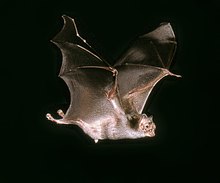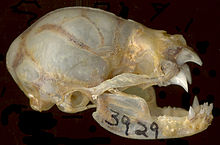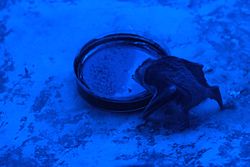Common vampire bat
| Common vampire bat | |
|---|---|

| |
| Scientific classification | |
| Domain: | Eukaryota |
| Kingdom: | Animalia |
| Phylum: | Chordata |
| Class: | Mammalia |
| Order: | Chiroptera |
| Family: | Phyllostomidae |
| Genus: | Desmodus |
| Species: | D. rotundus
|
| Binomial name | |
| Desmodus rotundus (Geoffroy, 1810)
| |

| |
| Range map | |
The common vampire bat (Desmodus rotundus) is a small, leaf-nosed bat native to the Neotropics. It is one of three extant species of vampire bat, the other two being the hairy-legged and the white-winged vampire bats. The common vampire bat practices hematophagy, mainly feeding on the blood of livestock. The bat usually approaches its prey at night while they are sleeping. It then uses its razor-sharp teeth to cut open the skin of its hosts and lap up their blood with its long tongue.
The species is highly
Taxonomy
The common vampire bat was first described as Phyllostoma rotundum by
A description published under the name Desmodus puntajudensi (Cuban vampire bat) by Woloszyn and Mayo in 1974 was later recognized as synonymous with this species.[11]
Physical description

The common vampire bat is short-haired, with silver-gray fur on its undersides, demarcated from the darker fur on its back.[3] It has a deeply grooved lower lip, and a flat, leaf-shaped nose.[3] A well-developed, clawed thumb on each wing is used to climb onto prey and to assist the animal in take-off.[3] The bat averages about 9 cm (3.5 in) long with a wingspan of 18 cm (7 in). It commonly weighs about 25–40 grams (2 oz), but its weight can drastically increase after a single feeding.[12] The braincase is relatively large, but the snout is reduced to accommodate large incisors and canines.[3] It has the fewest teeth among bats. The upper incisors lack enamel, which keeps them razor-sharp.[3] Its dental formula is 1.1.2.01.1.3.0, for a total of 18 teeth.[7]
While most other bats have almost completely lost the ability to maneuver on land, vampire bats are an exception.[13] They can run using a unique, bounding gait in which the forelimbs are used instead of the hindlimbs to propel forward, as the wings are much more powerful than the legs.[13] This ability likely evolved independently within the bat lineage.[13] Three pads under the thumb function like a sole.[3] It is also capable of leaping in various directions, heights, and distances.[14] When making a jump, the bat pushes up with its pectoral limbs. The hindlimbs keep the body over the pectoral limbs which are stabilized by the thumbs.[15]
Common vampire bats have good eyesight. They are able to distinguish different optical patterns and may use vision for long-range orientation.[3] These bats also have well-developed senses of smell and hearing: the cochlea is highly sensitive to low-frequency acoustics, and the nasal passages are relatively large.[3] They emit echolocation signals orally, and thus fly with their mouths open for navigation.[16] They can identify a metal strip 1 centimetre (0.39 in) wide at a distance of 50 centimetres (20 in), which is moderate compared to other bats.[16]
Range and habitat
The common vampire bat is found in parts of Mexico, Central America, and South America, as well as the
Behavior
Feeding

The common vampire bat feeds primarily on mammalian blood, particularly that of livestock such as cattle and horses.[18] Vampire bats feed on wild prey like the tapir, but seem to prefer domesticated animals, and favor horses over cattle when given the choice.[21] Female animals, particularly those in estrus, are more often targeted than males. This could be because of the hormones.[22]
Vampire bats hunt at night,[18] using echolocation and olfaction to track down prey.[23] They feed in a distance of 5 to 8 km (3.1 to 5.0 mi) from their roosts.[24] When a bat selects a target, it lands on it, or jumps up onto it from the ground,[18][24] usually targeting the rump, flank, or neck of its prey;[18] heat sensors in the nose help it to detect blood vessels near the surface of the skin.[21] It pierces the animal's skin with its teeth, biting away a small flap,[24] and laps up the blood with its tongue, which has lateral grooves adapted to this purpose.[25] The blood is kept from clotting by an anticoagulant in the saliva.[24]
They are protective of their host and will fend off other bats while feeding.[19][23] It is uncommon for two or more bats to feed on the same host, with the exception of mothers and their offspring.[19][23]
Mating and reproduction

Male vampire bats guard roosting sites that attract females,[26] but females often switch roosts. [26]
During estrus, a female releases one egg.
Cooperation

Regurgitated food sharing in common vampire bats has been studied in both the lab and field, and is predicted by kinship, association, and reciprocal help [27] In a field study conducted in Costa Rica from 1978 to 1983,[21] vampire bats frequently switched between several roost trees and co-roosted with kin and non-kin.[27] Mean genetic kinship within roosting groups was low (r = 0.03 − 0.11), but 95% of food sharing observed in the wild occurred between close kin (first cousins or higher). Most observed food sharing (70%) was mothers feeding their pups. The non-maternal sharing events were kin-biased suggesting that vampire bats prefer to help relatives.[27] However, non-maternal food sharing is even better explained by frequency of interaction, even after controlling for kinship. Food sharing was only observed when the co-roosting association was greater than 60%. Food sharing appears to require social bonds that require development over long periods of time.[27] Among familiar bats, the amount of food given from bat A to bat B is best predicted by the amount of food given from bat B to A.[27] Reciprocal sharing is most obvious over longer time spans as found in primate cooperation.
Vampire bats also participate in mutual grooming;[23] two bats groom each other simultaneously to clean one another, and to strengthen social bonds.[28] Bats that groom one another also share food. It was suggested that while grooming, a bat might assess the size of its partner's abdomen to determine if it really needs to eat.[28]
Relationship with humans

The highest occurrence of rabies in vampire bats occurs in the large populations found in South America. The danger is not so much to the human population, but rather to livestock.[29] Joseph Lennox Pawan, a government bacteriologist in Trinidad, found the first infected vampire bat in March 1932.[30] He soon proved various species of bat, including the common vampire bat, are capable of transmitting rabies for an extended period of time without artificial infection or external symptoms.[30] Fruit bats of the genus Artibeus were later shown to demonstrate the same abilities. During this asymptomatic stage, the bats continue to behave normally and breed. At first, Pawan's finding that bats transmitted rabies to people and animals were thought fantastic and were ridiculed.[citation needed]
Although most bats do not have rabies, those that do may be clumsy, disoriented, and unable to fly, which makes them more likely to come into contact with humans. There is evidence that it is possible for the rabies virus to infect a host purely through airborne transmission, without direct physical contact of the victim with the bat.
The unique properties of the vampire bats' saliva have found some positive use in medicine. A genetically engineered drug called desmoteplase, which uses the anticoagulant properties of the saliva of Desmodus rotundus, has been shown to increase blood flow in stroke patients.[34]
See also
- Chupacabra
- Hematophagy
- Peuchen
References
- . Retrieved 17 March 2022.
- ^ Geoffroy, E. (1810). "Sur les Phyllostomes et les Mégadermes, deux Genres de la famille des Chauve-souris". Annales du Muséum d'histoire naturelle. 15. G. Dufour, et Ed. d'Ocagne.: 181. Archived from the original on 2019-05-27. Retrieved 2019-05-27.
- ^ (PDF) from the original on 2014-05-23. Retrieved 2011-11-29.
- ^ Wied, M. (1826). Beiträge zur Naturgeschichte von Brasilien /. Vol. 2. Weimar: Im Verlage des Landes-Industrie-Comptoirs. pp. 231–238. Archived from the original on 2021-07-29. Retrieved 2019-05-27.
- ISBN 9780801882210
- ^ Thomas, O. (1901). "List of the mammals obtained by Dr. G. Franco Grillo in the Province of Parana, Brazil". Annali del Museo Civico di Storia Naturale di Genova. 2. 40. Tip. del R. Istituto Sordo-Muti: 546–549. Archived from the original on 2020-08-02. Retrieved 2019-05-28.
- ^ ISBN 978-0-226-19542-1.
- ^ JSTOR 3504240. Archived from the original(PDF) on 2014-05-24. Retrieved 2011-11-29.
- JSTOR 3504022. Archived from the original(PDF) on 2014-05-24. Retrieved 2011-11-29.
- ^ Ritter, Jana; Smedley, Rebecca and Benirschke, Kurt. "Vampire Bat Desmodus rotundus murinus". Diagnostic Center for Population and Animal Health, Michigan University. Archived from the original on 2018-09-06. Retrieved 2018-04-26.
{{cite web}}: CS1 maint: multiple names: authors list (link) - ISSN 2317-6105. Archived from the originalon 2018-06-18. Retrieved 2019-07-31.
- ^ Foraging vampire bats can expect big meals or none at all Archived 2015-09-03 at the Wayback Machine. socialbat.org (2015-08-31).
- ^
- ^ Altenbach, J. S. (1979) "Locomotor morphology of the vampire bat, Desmodus rotundus Archived 2017-09-28 at the Wayback Machine", Special publication (American Society of Mammalogists), no. 6.
- PMID 9359889.
- ^ PMID 610226.
- S2CID 52060593.
- ^ a b c d e f g h i j Lord R. D. (1993). "A Taste for Blood: The Highly Specialized Vampire Bat Will Dine on Nothing Else". Wildlife Conservation. 96: 32–38.
- ^ S2CID 13595734.
- ^ JSTOR 2388857.
- ^ doi:10.1038/scientificamerican0290-76. Archived from the original(PDF) on 2012-03-06. Retrieved 2011-09-11.
- JSTOR 1383209.
- ^ ISBN 0-87196-871-1
- ^ ISBN 0-8018-3970-X
- ^ a b Michael Mulheisen; Anderson, Rebecca. "Desmodus rotundus". Animal Diversity Web. Archived from the original on March 16, 2004. Retrieved December 16, 2011.
- ^ (PDF) from the original on 2014-03-13. Retrieved 2011-09-11.
- ^ PMID 24505498.
- ^ (PDF) from the original on 2018-07-22. Retrieved 2011-09-11.
- ^ Bat Facts Archived 2020-07-28 at the Wayback Machine Smithsonian. Retrieved 6 April 2011.
- ^ a b Joseph Lennox Pawan Archived 2016-03-04 at the Wayback Machine, Caribbean Council for Science and Technology. Retrieved 1 April 2011
- PMID 13880956.
These findings support consideration of an airborne medium, such as an aerosol, as the mechanism of rabies transmission in this instance.
- PMID 12203172.
Cryptic rabies cases are those in which a clear history of exposure to rabies virus cannot be documented, despite extensive case‐history investigation. Absence of a documented bite history reflects inherent difficulties in obtaining accurate animal‐contact information.... <gap> Thus, the absence of bite-history data does not mean that a bite did not occur.
- ^ CDC (April 22, 2011). "Learning about bats and rabies". Archived from the original on 10 January 2012. Retrieved 5 December 2011.
- (PDF) from the original on 2016-03-03. Retrieved 2011-09-14.

